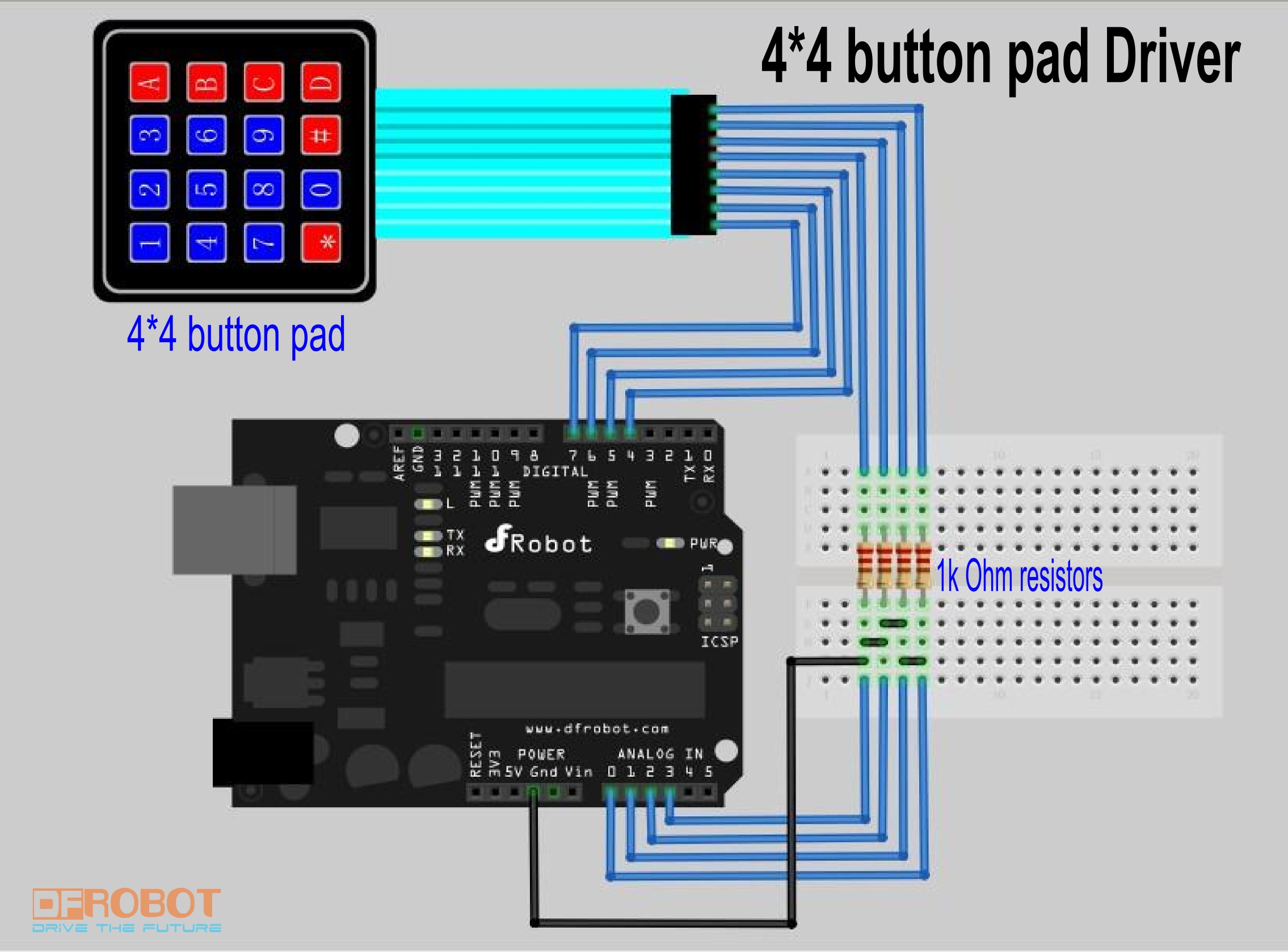Sealed_Membrane_4*4_button_pad_with_sticker_(SKU_FIT0129) - jimaobian/DFRobotWiki GitHub Wiki

Introduction
The 4x4 Keypad is a general purpose 16 button (4x4) matrix keypad. It comes ready to work, simply peel-off the adhesive backing, stick it to your surface and plug it in.
 User guides
User guides
This is a simple application of port manipulation using Arduino to paly with the 4*4 button pad. Before read the code, you'd better see the connection diagram first. We use four digital ports as HIGH voltage scanning the row of button pad and four analog ports to read the column of button pad connected with four pull-down resistors. If button is pressed,the voltage will be HIGH when it is scanned by HIGH voltage concurrently. Otherwise, the voltage is pulled down and will be LOW. Using eight ports totally, we can read 16 buttons.
Connecting Diagram

Sample Code
/*
Description:
sample code for Sealed membrane 4*4 nutton pad with sticker, it outputs the ASCII code for keys on the pad.
The general working principle of this key pad is a 4*4 matrix. The sample code scans the 4*4 matrix in a short time
and determines whether there is a signal input( pression on the keypad).
Before reading this sample code, you'd better have a look at the sample connection pic. You may wonder why there are
four resistors. This is because that if there are no such resistors, the data analogRead() gets will be a stochastic value
between 0-1023. It will be impossible to determine whether the connection is made by pressing the button on the key pad.
*/
//Author: Sheng Kaiyu from DFrobot
//Editor: Michael from DFrobot
//Date: 2012/02/23
// Arduino 1.0 or lower
void setup()
{
DDRD=240; //binary 11110000, set the digital I/O pin 7-4 as output
Serial.begin(9600); // use serial monitor to view the input
}
unsigned char outputchar(int i, int j) // output chars on the pad
{
if (i==0)
{ switch (j)
{case 0:
return '1'; break;
case 1:
return '2'; break;
case 2:
return '3'; break;
case 3:
return 'A'; break;
}
}
if (i==1)
{ switch (j)
{case 0:
return '4'; break;
case 1:
return '5'; break;
case 2:
return '6'; break;
case 3:
return 'B'; break;
}
}
if (i==2)
{ switch (j)
{case 0:
return '7'; break;
case 1:
return '8'; break;
case 2:
return '9'; break;
case 3:
return 'C'; break;
}
}
if (i==3)
{ switch (j)
{case 0:
return '*'; break;
case 1:
return '0'; break;
case 2:
return '#'; break;
case 3:
return 'D'; break;
}
}
}
unsigned int getC() //determine whether there is 5V input on the analog pins 3-0
{
if (analogRead(3)>512) // binary 1000, pin 3 has a 5V input
{
return 0x8;
}
else if (analogRead(2)>512) // binary 0100, pin 2 has a 5V input
{
return 0x4;
}
else if (analogRead(1)>512) // binary 0010, pin 1 has a 5V input
{
return 0x2;
}
else if (analogRead(0)>512) // binary 0001, pin 0 has a 5V input
{
return 0x1;
}
else // binary 0000, no pin has 5V input, namely no button is pressed
{
return 0x0;
}
}
unsigned char readdata(void) //main function
{
PORTD=128; //binary 10000000, set pin 7 HIGH
for (int i=0;i<4;i++) //for loop
{
unsigned int temp=0x8; //temporary integer, binary 1000, to compare with getC() function and determine pression
for (int j=0;j<4;j++)
{
if (getC()==temp)
{ return outputchar(i,j);} // output the char
temp=temp>>1 ; // shift right
}
PORTD=PORTD>>1; //shift right, set the next pin HIGH, set previous one LOW
}
return 'E'; // if no button is pressed, return E
}
void loop()
{
unsigned char key;
do // read and output once until the next pression
{ key=readdata();
if (key!='E')
{Serial.println(key);}
delay(200);
while (readdata()==key)
{}
}
while (key!='E');
}
Advanced application
Though the previous sample code can drive the button pad. However, this method wastes eight I/O ports. We strongly recommend an other product GPIO, which transforms between parallel and serial data transmission mode. Thus, with a GPIO, we can expand at most 16 I/O ports only using an IIC interface.
We have written a more useful code to drive this button pad with a GPIO. Only two I/O ports of Arduino board are used using IIC interface.(Analog 4 for SDA(data) and analog 5 for SCL(clock))
Let's see details in GPIO wiki.
 shopping (sku:fit0129)
category: Product Manual category: FIT Series
shopping (sku:fit0129)
category: Product Manual category: FIT Series